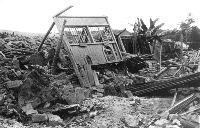Origin time 06:43 local time Depth 6 km (4 mi) | Magnitude 7.1 ML Max. intensity IX (Violent) | |
 | ||
Date March 17, 1906 (1906-03-17) | ||
The 1906 Meishan earthquake (Chinese: 1906年梅山地震; pinyin: 1906 nián Měishān Dìzhèn) was centered on Moe'akhe (Chinese: 梅仔坑; Pe̍h-ōe-jī: Môe-á-kheⁿ), Kagi-cho, Japanese Taiwan (modern-day Meishan, Chiayi County, Taiwan) and occurred on March 17. Referred to at the time as the Great Kagi earthquake (Chinese: 嘉義大地震; pinyin: Jiāyì Dà Dìzhèn), it is the third-deadliest earthquake in Taiwan's recorded history, claiming around 1,260 lives. The shock had a Richter magnitude of 7.1 and a Mercalli intensity of IX (Violent).
Contents
Earthquake
The earthquake struck at 06:43 local time on March 17, 1906, with a Richter magnitude of 7.1 and a focal depth of 6 kilometres (4 mi). The event created the Meishan fault, a fault line with a length of 25 kilometres (16 mi) stretching through modern-day Chiayi County. Aftershocks continued throughout the day, hampering rescue efforts.
Damage
Reports vary slightly, but according to the official Central Weather Bureau summary, the casualties and damage were as follows:
Fusakichi Omori, a pioneering seismologist from Japan who arrived shortly after the earthquake believed that the high number of casualties was due to the construction of the local houses. Loosely cemented with mud, the combination of sun-dried mud brick walls and heavy roofing beams was thought to be responsible for many dwellings collapsing, killing or injuring the inhabitants. He also found evidence of soil liquefaction, and stated that the town of Bishō (Meishan) had been completely destroyed by the quake.
Omori's figures give slightly different casualty rates, and very different statistics for building damage:
Reaction
The veteran missionary William Campbell wrote concerning the quake:
I was there soon after, and had a profound feeling of sadness on seeing whole streets covered with fallen beams and other debris; on seeing, too, so many traces of the awful suffering on every side. Within Ka-gi city, and a limited area around, 1,216 persons were suddenly thrust out into the eternal world. Not fewer than 2,306 persons were seriously injured, and 13,259 houses laid low. The great mysterious Power then tore the earth into deep, open chasms in several places.
The Japanese colonial authorities in Taihoku (Taipei) sent teams of medical personnel to assist, and Campbell reported that shortly after the earthquake reconstruction efforts were well advanced. At the time some writers suggested a link between the Meishan quake and the great 1906 San Francisco earthquake, which occurred a month later, while some religious groups linked it not only with the San Francisco disaster, but also an earlier earthquake in Cambria, Italy and other natural disasters as a sign of the end-times.
